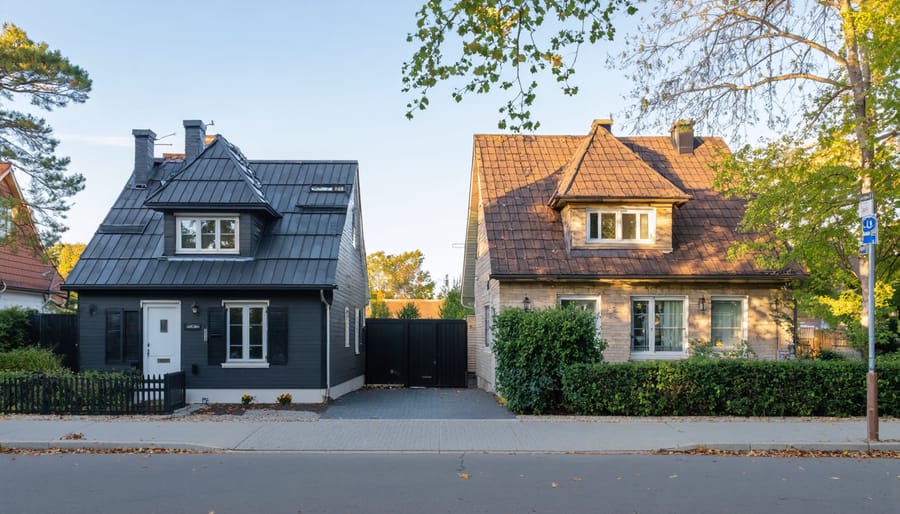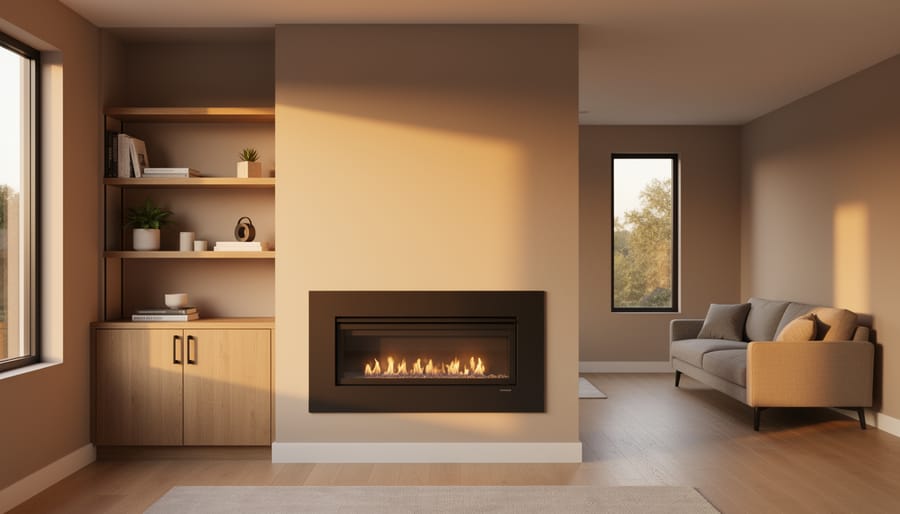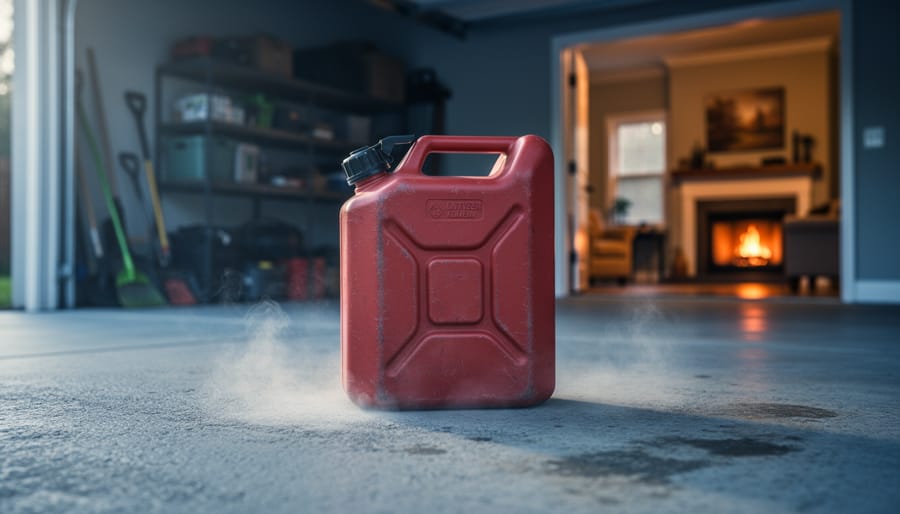Compare the upfront investment against long-term value by examining metal roofing’s 40-70 year lifespan versus asphalt shingles’ 15-30 year expectancy—a metal roof may cost two to three times more initially but often requires only one installation in your lifetime while shingles demand multiple replacements.
Evaluate your climate’s specific demands since metal roofing excels in areas with heavy snow, high winds, or wildfire risk, shedding precipitation efficiently and resisting ember ignition, whereas quality architectural shingles perform admirably in moderate climates with proper ventilation and maintenance.
Calculate energy savings potential through metal roofing’s reflective properties that can reduce cooling costs by 10-25 percent in warm climates, contributing to overall home comfort and lower utility bills—an eco-friendly consideration that compounds over decades.
Consider your home’s architectural style and neighborhood aesthetics since standing seam metal offers sleek, contemporary appeal while traditional shingles provide classic versatility with extensive color options, ensuring your choice enhances rather than detracts from curb appeal.
Account for noise levels and insulation requirements as metal roofing can amplify rain sounds without proper underlayment and insulation layers, though modern installation techniques minimize this concern for homeowners prioritizing both ambiance and practical performance.
The right roofing material depends less on which option is universally superior and more on how each aligns with your budget timeline, environmental values, and home’s specific needs. This comprehensive comparison examines every critical factor to guide your decision with confidence and clarity.
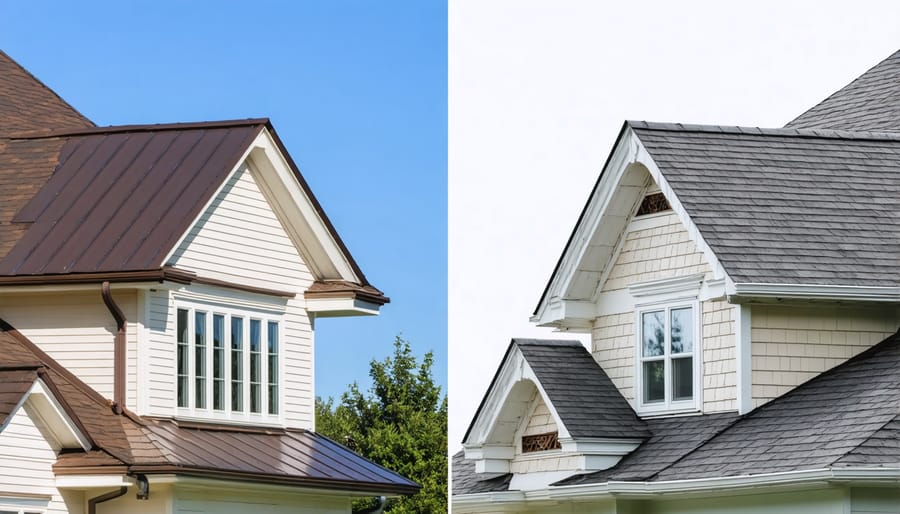
The Aesthetic Appeal: More Than Just Curb Appeal
Metal Roofing’s Modern Elegance
Metal roofing has evolved far beyond the barn and industrial warehouse aesthetic of decades past. Today’s metal roofing options bring a sleek, contemporary elegance that perfectly complements modern home designs, especially those featuring statement fireplaces and architecturally striking chimneys.
The variety available in metal roofing is truly impressive. Standing seam panels create crisp, vertical lines that add height and drama to your roofline, while metal tile roofs can mimic the look of traditional materials with added longevity. Corrugated metal offers an industrial-chic vibe that pairs beautifully with exposed brick chimneys and modern outdoor living spaces centered around fire features.
What makes metal roofing particularly appealing for fireplace enthusiasts is how it harmonizes with contemporary chimney designs. A brushed steel roof can echo the metallic accents of a modern fireplace surround, creating visual cohesion throughout your home. The clean lines of metal roofing also provide an ideal backdrop for dramatic chimney structures, whether you’re showcasing a towering stone chimney or a minimalist modern design.
Beyond aesthetics, metal roofing reflects heat rather than absorbing it, contributing to your home’s overall energy efficiency. This complements eco-friendly heating solutions by reducing cooling costs during warmer months, allowing you to invest more in the cozy warmth of your fireplace when temperatures drop.
The Timeless Charm of Shingles
There’s something wonderfully reassuring about the look of traditional asphalt shingles gracing a rooftop. For generations, these familiar overlapping tiles have defined what “home” looks like in neighborhoods across the country. Their classic appearance carries a warmth that naturally complements homes with cozy, traditional features—especially those centered around the inviting glow of a wood-burning fireplace.
Asphalt shingles offer remarkable versatility when it comes to aesthetics. Available in countless colors, textures, and styles, they can enhance everything from charming cottages to stately colonials. Whether you’re drawn to weathered slate appearances, rustic wood-shake textures, or clean architectural lines, there’s a shingle design to match your vision. This design flexibility makes them particularly appealing if you’re creating a cohesive look that celebrates traditional home comfort.
For homeowners who view their house as a lifestyle sanctuary—a place where warmth emanates not just from efficient heating solutions but from the overall aesthetic—shingles deliver that familiar, inviting presence. They blend seamlessly with natural materials like stone and wood, creating visual harmony that feels both timeless and welcoming. If your home features classic architectural elements and you value that established neighborhood character, shingles provide an authentic, tried-and-true aesthetic that rarely disappoints.
Durability Face-Off: Which Roof Protects Your Hearth Longer?
Metal Roofing’s Remarkable Lifespan
When it comes to protecting your home and everything within it—including your cherished fireplace and heating systems—longevity matters tremendously. Metal roofing truly shines in this department, offering an impressive lifespan that far surpasses traditional asphalt shingles.
A quality metal roof can last anywhere from 40 to 70 years, depending on the material you choose. Compare that to asphalt shingles, which typically need replacement every 12 to 20 years, and the value becomes crystal clear. This extended lifespan means fewer disruptions to your home life and less worry about protecting your chimney structures and fireplace ventilation systems over the decades.
For homeowners who rely on fireplaces and wood stoves as part of their lifestyle and heating strategy, metal roofing’s fire resistance is particularly valuable. Metal won’t ignite or contribute to fire spread, providing an extra layer of protection for homes with active fireplace systems and chimney structures. This peace of mind is invaluable, especially in areas prone to wildfires or where sparks from neighboring properties could pose risks.
Beyond fire protection, metal roofs stand strong against wind speeds up to 140 miles per hour and resist hail damage that would crater or crack asphalt shingles. They’re also remarkably low-maintenance—no curling, cracking, or missing pieces to monitor. A simple annual inspection and occasional debris removal are typically all that’s needed.
This durability means your roof will continue protecting your home’s warmth and comfort year after year, allowing you to focus on enjoying cozy evenings by the fire rather than worrying about your roof’s condition.
Shingle Durability: The Realistic Timeline
Asphalt shingles typically deliver 15 to 30 years of protection for your home, though their actual lifespan depends heavily on your local climate and how well you maintain them. Think of shingles as the hardworking but weather-sensitive option that needs a bit more attention over the years.
Weather takes its toll on shingles in ways that directly impact your home’s comfort and safety. Heavy winds can lift or tear individual shingles, creating vulnerable spots where water seeps through. Hail damage often isn’t immediately visible but weakens the protective granules, accelerating deterioration. In areas with temperature swings, shingles expand and contract, leading to cracks and curling edges. These issues aren’t just cosmetic concerns—they affect how well your home maintains its cozy indoor environment and protects what’s inside.
For homeowners who cherish gathering around an active fireplace, fire ratings become particularly important. Standard asphalt shingles typically carry a Class A fire rating, offering the highest level of fire resistance. However, this rating can diminish as shingles age and their protective granules wear away, making regular inspections essential for homes where fireplaces create warmth and ambiance.
Maintenance requirements add up over time. You’ll need periodic inspections, especially after severe weather, prompt replacement of damaged shingles, and clearing debris from valleys and gutters. While these tasks aren’t overly complex, they’re necessary investments in protecting your home’s envelope and maintaining that comfortable, secure feeling every homeowner values. Regular upkeep helps maximize your shingle roof’s lifespan and keeps your heating costs manageable by preventing air leaks.
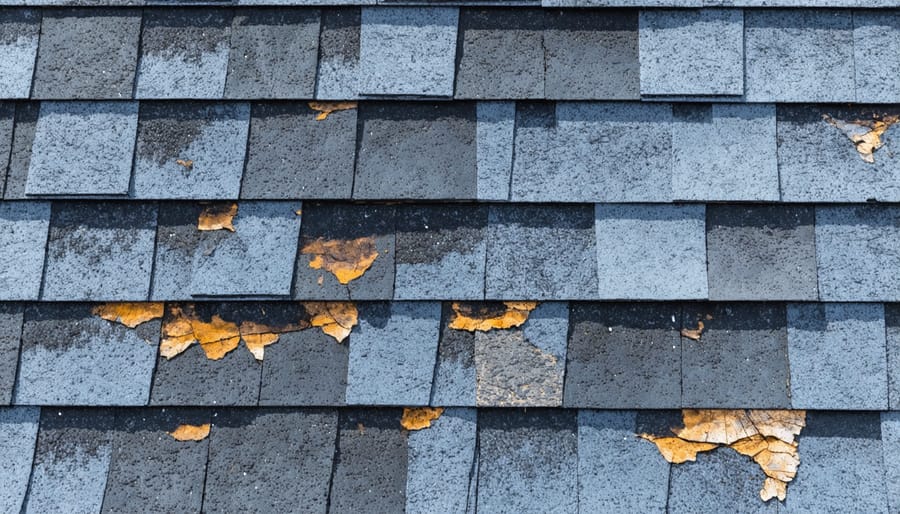
Energy Efficiency and Your Heating Bills
Metal’s Reflective Properties
One of metal roofing’s standout features is its natural ability to reflect solar heat, which can make a meaningful difference in your home’s overall comfort and energy efficiency. During those hot summer months, metal roofs work like mirrors for the sun’s rays, reflecting a significant portion of solar radiation away from your home rather than absorbing it. This reflective quality can reduce cooling costs by up to 25 percent, meaning your air conditioning system doesn’t have to work as hard to keep your living spaces comfortable.
When winter arrives and you’re gathering around your fireplace for warmth and ambiance, metal roofing continues to contribute to your home’s efficiency. While the reflective properties focus on keeping heat out during summer, proper insulation underneath your metal roof ensures that the cozy heat from your fireplace and heating system stays inside where it belongs. This creates a more balanced approach to home comfort throughout the year.
The key is pairing your metal roof with quality insulation and regular heating system maintenance. Together, these elements create an eco-friendly heating solution that reduces your reliance on fossil fuels while maintaining that warm, inviting atmosphere every homeowner desires. It’s a practical investment that supports both your comfort and environmental values.
Shingles and Heat Retention
Traditional asphalt shingles have a reputation for absorbing heat during sunny days, which can impact your home’s overall comfort and heating needs. These shingles tend to soak up solar radiation, warming your attic space and, by extension, the living areas below. While this heat absorption might seem beneficial during winter months, it actually creates challenges for maintaining consistent indoor temperatures.
The insulation value of shingles themselves is minimal, meaning they don’t provide much of a barrier against heat transfer in either direction. During cold months, the heat your fireplace works hard to generate can escape more easily through a roof with poor thermal performance. This means your heating system, whether it’s a cozy wood-burning fireplace or another eco-friendly heating solution, needs to work harder to maintain that warm, inviting atmosphere you’re after.
What’s interesting is how shingles interact with your home’s heating strategy. Because they don’t reflect heat efficiently, shingles can contribute to uneven temperature distribution throughout your home. This matters especially if you’re relying on a fireplace as a primary or supplementary heat source, as you want that warmth to stay where it belongs rather than escaping through your roof system.
Installation and Chimney Considerations
When you’re planning a roofing project for a home with a fireplace and chimney, understanding how your roofing choice affects installation is essential for both safety and long-term performance.
Metal roofing and asphalt shingles require different approaches when it comes to chimney flashing, which is the critical weatherproofing barrier where your roof meets the chimney. Metal roofs typically use specialized flashing systems with standing seam profiles that accommodate the roof’s natural expansion and contraction. These systems often involve more complex installation techniques but create exceptional water-tight seals that protect your home for decades. Shingle roofs use step flashing that’s woven between layers, which is more straightforward to install but may require more frequent maintenance over time.
Weight considerations matter significantly for your home’s structure. Metal roofing weighs considerably less than asphalt shingles, typically between 1 to 3 pounds per square foot compared to 2 to 4.5 pounds for standard shingles. If you’re considering a complete renovation that includes upgrading your heating system or adding a new fireplace, this lighter weight can be advantageous for older homes with structural limitations.
The roof replacement timeline also differs between materials. Metal roofing installation around chimneys requires specialized expertise and takes longer initially, but you’ll benefit from fewer future repairs. Shingle installation is generally quicker, though proper chimney integration still demands skilled craftsmanship.
From an eco-friendly perspective, metal roofing’s longevity means fewer disruptions to your home’s heating efficiency over time. Once properly installed around your chimney, metal roofs maintain their integrity without the gradual deterioration that can compromise the seal around your fireplace’s ventilation system, helping maintain optimal draft and energy efficiency throughout your home.
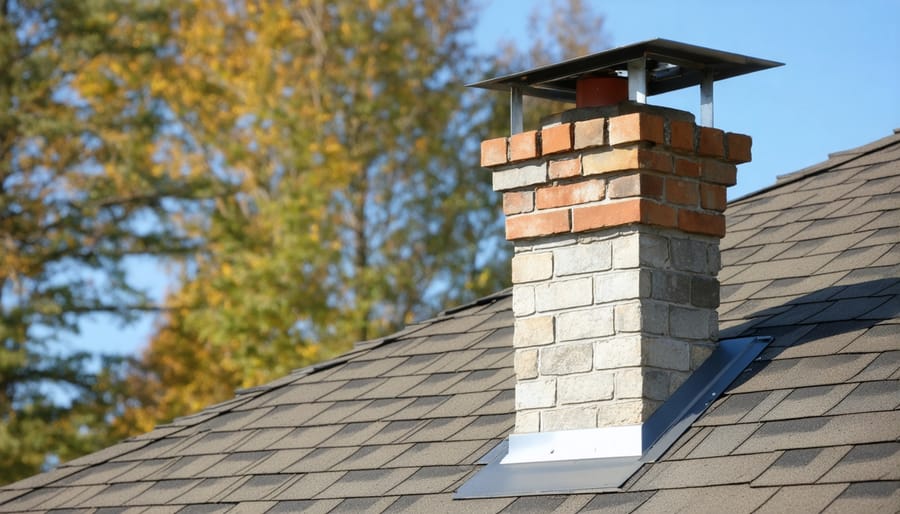
Cost Reality: Investment vs. Value
Let’s talk numbers, because protecting your home is an investment that deserves honest conversation. Asphalt shingles typically cost between $3.50 to $5.50 per square foot installed, making them the more budget-friendly choice upfront. Metal roofing runs $7 to $14 per square foot, which can feel like sticker shock when you first see the estimate.
But here’s where the story gets interesting. Those shingles you’re installing today? You’ll likely replace them in 15-20 years, meaning you might roof your home twice, possibly three times over the decades you live there. Metal roofing, meanwhile, can last 40-70 years, essentially becoming the last roof your home will ever need during your ownership.
Think about it from a home comfort perspective. If you’re investing in efficient heating solutions to keep your family cozy, your roof choice directly impacts those efforts. Metal roofing’s superior insulation properties mean your heating system works less overtime during winter months. Those energy savings add up year after year, typically reducing heating and cooling costs by 10-25 percent. That’s money staying in your pocket instead of escaping through your roof.
The return on investment becomes clearer when you factor in maintenance costs. Shingles require periodic repairs, replacements of damaged sections, and eventual full replacement. Metal roofs? Minimal maintenance beyond occasional inspections.
For homeowners prioritizing long-term value and home comfort, metal roofing often pays for itself within 15-20 years through energy savings and avoided replacement costs. Yes, you’ll feel the initial investment, but you’re buying decades of protection, efficiency, and peace of mind for your home and everything warm and valuable inside it.
Environmental Impact: Choosing the Greener Roof
When thinking about your home’s environmental footprint, your roof choice matters more than you might expect, especially when considering how it works alongside other eco-friendly home solutions like efficient heating systems.
Metal roofing takes a clear lead in sustainability. Most metal roofs contain 25-95% recycled content, and when they eventually reach the end of their lifespan (which can be 50+ years), they’re 100% recyclable. Compare that to asphalt shingles, where approximately 11 million tons end up in landfills annually. That’s a significant environmental burden that shouldn’t be overlooked.
From an energy perspective, metal roofs reflect solar heat rather than absorbing it, which can reduce your cooling costs by 10-25%. This reflective quality means your home stays naturally cooler in summer, reducing the strain on air conditioning. During winter months when you’re relying on your fireplace or heating system to keep things cozy, a properly insulated metal roof helps retain that warmth more effectively.
The manufacturing process for metal roofing generally has a lower carbon footprint over its lifetime because of its durability. While asphalt shingles need replacement every 15-20 years, creating repeated manufacturing and disposal cycles, metal roofing’s longevity means fewer resources consumed over your home’s lifetime. For homeowners committed to reducing their environmental impact while maintaining a comfortable, energy-efficient living space, metal roofing aligns better with sustainable home values.
So, is metal roofing better than shingles? The honest answer is that it depends entirely on what matters most to you and your home. If you’re planning to stay in your home for decades and value long-term savings, metal roofing’s durability and energy efficiency make it an excellent investment. The initial cost may be higher, but you’ll likely never need to replace your roof again, and those energy savings add up beautifully over time, especially when paired with efficient heating solutions.
On the other hand, if upfront cost is your primary concern or you prefer the traditional aesthetic that many neighborhoods embrace, quality asphalt shingles remain a solid, time-tested choice. They’re easier to install, more affordable initially, and offer respectable performance for their price point.
Think about your home as a complete comfort system. Just as you carefully consider how to heat your space efficiently and sustainably, your roofing choice impacts your overall energy consumption and environmental footprint. Consider your climate, your budget both now and long-term, your aesthetic preferences, and your commitment to eco-friendly living.
The best decision is the informed one. Evaluate your priorities, get multiple quotes from qualified contractors, and choose the option that aligns with both your practical needs and your vision for creating a comfortable, efficient home you’ll love for years to come.

